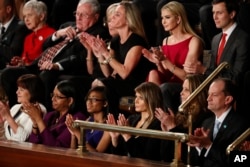The day after President Donald Trump’s address to a joint session of Congress, much of official Washington seemed to be focused on the president’s projection of a softer, more optimistic tone in his speech.
Now supporters, critics and analysts are all wondering if this change is but a fleeting moment in the ever-changing world of Donald Trump, or is it something that is here to stay? It is a key question as Congress begins the task of grappling with Trump’s ambitious domestic agenda and tries to turn campaign promises into reality.
The president met with Republican congressional leaders at the White House Wednesday to discuss moving forward on his ambitious policy agenda. “We’re just here to start the process. It begins as of now and we think we are going to have tremendous success,” Trump told them.
Riding high
Trump got some good reviews for Tuesday’s address to the joint session of Congress, with a lot of positive feedback on his softer, more optimistic tone. Perhaps the most bipartisan moment in Trump’s speech came near the end when he appealed to all Americans to “embrace” what he called a “renewal of the American spirit.”
“I am asking everyone watching tonight to seize this moment, believe in yourselves, believe in your future and believe once more in America,” he said.
It was a presidential moment for a president in need of one, analyst Jeremy Mayer of George Mason University in Virginia told VOA on Skype.
“This was the best speech I’ve seen the man give, and I’ve been watching him very closely," he said. "There was an air of compromise, an air of calmness, of ‘let’s all work together’ that you just don’t see in Donald Trump’s rhetoric very often.”
John Fortier of the Bipartisan Policy Center in Washington agreed.
“We’re used to seeing a much more combative Donald Trump. It was much more optimistic in tone. He hit the themes from his campaign, but he did it in a much more positive way,” he told VOA’s Afghan Service.
The battles to come
Trump’s shift in tone could help with tough congressional battles to come over health care and tax reform, among others.
“A lot of the details and the ‘how to do it’ is still very much a difficulty for him," Fortier added. "So for him to show some leadership and to show that he has a path to work with these Republicans who are broadly with him but there are many, many obstacles ahead, I think that is something that he would be wise to do.”
But Fortier also estimated it could take several months, or perhaps up to two years, to make real headway on some of Trump’s goals given the complexities of repealing and replacing the Affordable Care Act - known as Obamacare - and enacting comprehensive tax reform.
Partisan reaction
Republicans by and large hailed the speech. House Speaker Paul Ryan said it was "a home run," while Vice President Mike Pence said the speech showed the president's "broad shoulders" and "big heart."
But many Democrats remain skeptical that Trump’s change in tone is a lasting phenomenon, including Senate Democratic leader Chuck Schumer.
“His speeches are always totally detached from reality,” Schumer told ABC’s Good Morning America. “He talks to the working folks of America. They were his main constituency. But the way he’s governed has been totally with the hard-right, special interests against the working people.”
Poll bump
Trump got a polling bump after his speech to Congress. A CBS/YouGov poll reported that 76 percent of those surveyed had a positive reaction to the address, and 82 percent found it “presidential.”
Another survey by CNN/ORC found that 70 percent said the speech made them feel more optimistic about the direction of the country.
The polls have generally been a weak area for Trump early in his presidency, with an average approval rating of under 45 percent. American University analyst James Thurber noted that Trump has been registering the lowest approval ratings of any new president since pollsters began measuring during the presidency of Dwight Eisenhower in the 1950s.
Watch: Trump's Softer, More Optimistic Tone Sparks Debate in Washington
Lasting shift or moment in time?
Republicans and Democrats alike are also wondering whether the softer, more disciplined Trump on display Tuesday night at the Capitol is here to stay.
“Trump has shown last night that he is up to the job of acting like a real president, finally,” said Jeremy Mayer. “But actually doing the work, [it’s] yet to be seen if he can do that.”
Trump has done mini-pivots in the past, only to revert to more familiar campaign-style figure from the 2016 presidential campaign, said Republican strategist John Feehery.
“He’s not going to change that much because he’s a 70-year-old man who has been successful in his life doing what he’s been doing, and he’s not going to magically transform himself," he said. "So I think we all have to be kind of realistic about what he can do to change.”


